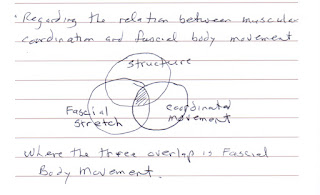I haven't been training since April 4. This intestinal problem and other daily life stressors continue to sap my energy and willpower to do anything.
* At the May 14th Wujifa class, while our instructor is standing in front of my school brother and adjusting his stance...
Me: Hey, I can see a break in the connection through the hips and kua.
Instructor: The break is due to the arch in his back.
Me: Do you know the front because of the back?
Instructor: I see the whole and you are seeing parts trying to discern the whole.
Me: So are there different levels of seeing? Do you begin by seeing parts first and then at higher levels you can see the whole?
Instructor: You tend to focus too narrowly. Don't focus so narrowly. Look globally. What do you see?
Me: Wow! It's as if I can see through him and I see how his tight back is affecting his front. It's like having some kind of three dimensional x-ray vision. I've never seen this way before!
* Regarding my stance. I still have tension above the pubic bone and in each kua. Less than before, but still some there. I need to continue releasing these.
* In class, we worked on my stance a little, showing me a different way to help me to feel how to get my kua more relaxed and "in":
- Get into the standard Wujifa zhan zhuang stance. Then simultaneously, thrust your chest up and forward, hyper arch your back by leaning slightly forward and sticking your butt as far up and back as possible, and relax your belly.
Put your hands in your pants pockets and feel the muscles under your pockets - the inguinal crease. Feel how the muscles are soft and in. This is the feeling you are aiming for.
- While maintaining the chest up and butt back, pivot on the femur head and lean your entire torso slightly backward. Keep the inguinal crease soft. Stretch the lower abdominal to pubis so that it stays relaxed and soft. Get a positional release in front so you don't engage the front to tuck.
In this second step, the softness of your inguinal crease is your bio-feedback device. If you feel the muscles under your fingers activating, then start over because you're doing it wrong.
- Simultaneously, slide the knees forward as you slowly release the arch as if sitting down. Then bow forward slightly and maintain the softness in the inguinal crease. You should feel that the kua (inguinal crease) goes in more as your back straightens.
In this third step, a typical problem is that the muscles under the fingers get taut which means you are engaging your abdominal muscles; you are "tucking". Notice that this level of tucking is much more subtle and deceptive than what most people practice. Finally, the soft/in feeling should feel like a kind of "sucking-in" feeling at the kua as you adjust from #1 to #3.
(I found this method to be very helpful in terms of giving me a way to feel, albeit with my fingers, where I lack the ability to feel my internal kinesthetics, and in terms of calibrating where I'm losing the soft/in feeling in my kua.)
(Note: I seriously injured my left knee during high school and within months of the injury, a torn miniscus was surgically removed. As I've learned in more recent years particularly with Rolfing, is that my body compensated for the injury. In fact, my right knee had become problematic, probably as a result of this compensation. As I untwist and relax my structure, I'm cautiously mindful of the effects on this knee.)
Further reading:
Introductory article explaining this "Journal Notes" series: Zhan Zhuang Training Journal
Previous article in this series: Training Submission:Journal Notes #101
Next article in this series: - Learning From Myself: Journal Notes #103




